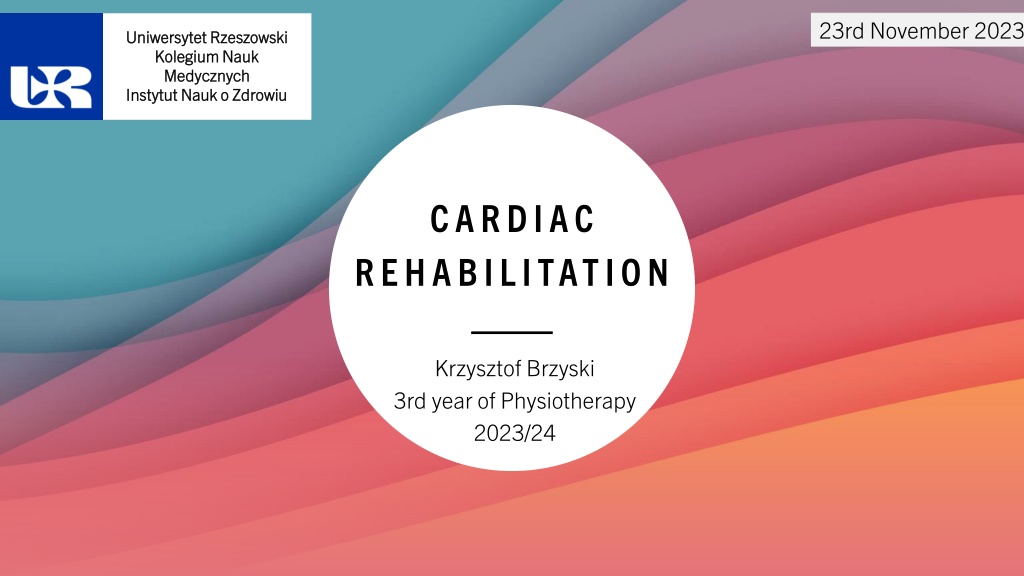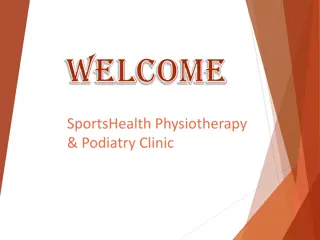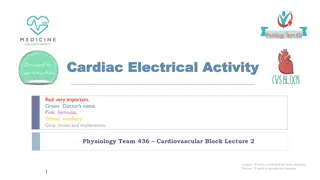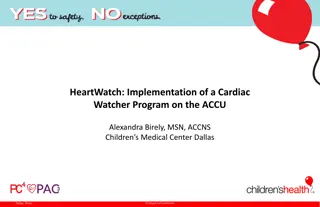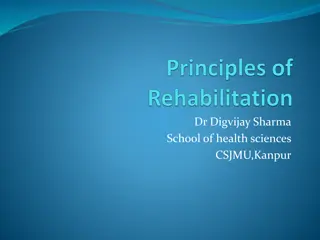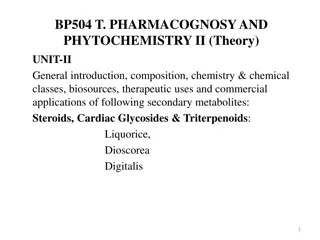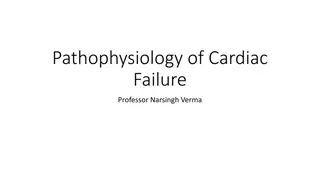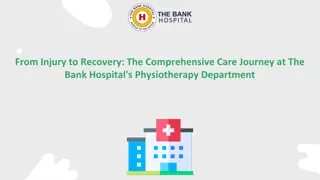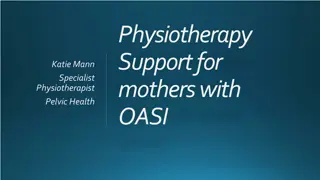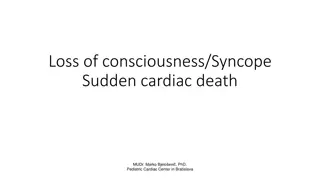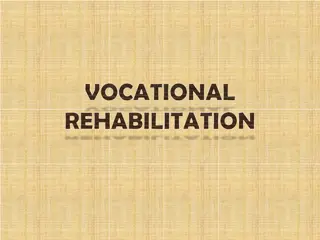Understanding Cardiac Rehabilitation and Physiotherapy Approaches
Explore the comprehensive agenda covering topics like the general structure of the circulatory system, blood circulation in the human body, risk factors for cardiovascular diseases, and physiotherapeutic approaches in cardiac rehabilitation. Gain insights into the anatomy of the heart, arteries, veins, and key terms related to cardiovascular health. Discover the importance of physical activity, diet, and sleep in preventing cardiac issues. Learn about coronary heart disease and how a healthy artery functions in the body.
Download Presentation

Please find below an Image/Link to download the presentation.
The content on the website is provided AS IS for your information and personal use only. It may not be sold, licensed, or shared on other websites without obtaining consent from the author. Download presentation by click this link. If you encounter any issues during the download, it is possible that the publisher has removed the file from their server.
E N D
Presentation Transcript
23rd November 2023 Uniwersytet Rzeszowski Uniwersytet Rzeszowski Kolegium Nauk Kolegium Nauk Medycznych Medycznych Instytut Nauk o Zdrowiu Instytut Nauk o Zdrowiu CARDIAC REHABILITATION Krzysztof Brzyski 3rd year of Physiotherapy 2023/24
AGENDA 1. Glossary 2. General structure of the circulatory system - Structure of the heart 3. General structure of the circulatory system - Structure of arteries and veins 4. Blood circulation in the human body - Small and large circulation 5. Risk factors for cardiovascular diseases 6. Physiotherapeutic approach in a selected disease entity 7. Quiz 8. Bibliography
1. Artery Ttnica 2. Aorta Aorta 3. Superior/inferior vena cava - y a g wna g rna/dolna 4. Bicuspid valve (Mitral valve) - Zastawka dwudzielna (Zastawka mitralna) 5. Tricuspid valve - Zastawka tr jdzielna 6. Right atrium - Prawy przedsionek 7. Right ventricle - Prawa komora 8. Coronary heart disease - Choroba wie cowa 9. Atherosclerosis Mia d yca 10. Chest pain - B l w klatce piersiowej 11. Shortness of breath Duszno 12. Cardiac arrhythmias - Zaburzenia rytmu serca 13. Systemic circulation - Obieg krwi du y (uk ad kr enia og lnoustrojowego) 14. Pulmonary circulation - Obieg krwi ma y (uk ad kr enia p ucnego) 15. Arrhythmia Arytmia 16. Heart rate - T tno (cz sto rytmu serca) GLOSSARY
GENERAL STRUCTURE OF TH E CIRCUL ATORY SYSTEM - STRUCTURE OF TH E H EART superior vena cava Pulmonary veins Aorta Right atrium Left atrium Tricuspid valve Bicuspid valve (Mitral valve) Right ventricle Left ventricle inferior vena cava https://pl.wikipedia.org/wiki/Zastawki_serca
GENERA L STRUCTURE OF TH E CIRCUL ATORY SYST EM - STRUCTURE OF ARTERIES AND VEINS Artery Vein 1. Outer membrane 2. Middle membrane 3. Inner membrane https://zpe.gov.pl/pdf/PHaLJW4WW
https://fizjoterapeuty.pl/uklad-krwionosny/krwiobieg.html BLOOD CIRCULATION IN THE HUMAN BODY - SMALL AND LARGE CIRCULATION Pulmonary circulation Systematic circulation
RISK FACTORS FOR CARDIOVASCULAR DISEASES Physical activity Smoking Diet Sleep
PHYSIOTHERAPEUTIC APPROACH IN A SELECTED DISEASE ENTITY Coronary heart disease (ischemic heart disease) Healthy artery Artery with accumulated atherosclerotic plaque atherosclerosis https://upacjenta.pl/poradnik/miazdzyca
CORONARY HEART DISEASE Physiotherapeutic goals in the treatment of coronary heart disease: 1. Improving the heart's function by reducing peripheral resistance, 2. Slowing down heart activity, 3. Enhancing its blood supply.
C O R O N A R Y H E A R T D I S E A S E R E H A B I L I TAT I O N P L A N ( M O D E L A ) Period 1 Period 1 Period 2 Period 2 Period 3 Period 3 1 day 2 days 3-5 days 5-10 min. 10-15 min. 15-20 min Position Position for for exercises exercises - Lying position - Semi-sitting position - Sitting position - Sitting position - Sitting position - Standing position - Walking position Rehabilitation Rehabilitation plan plan 1. Breathing exercises 2. Active dynamic exercises from small to larger muscle groups isometric contractions of small muscle groups 3. Relaxing exercises 4. Passive uprighting or with assistance 1. Exercises from period I with an increase in physical exercise load - Increase in the number of exercise repetitions - Increase in the pace of exercises - Increase in the number of exercise sets 2. Elements of coordination and balance exercises 3. Uprighting 4. Moving within the patients 1. Exercises from period II with further increase in physical exercise load 2. Exercises of large muscle groups with a general rehabilitative character 3. Locomotion: - Walking training - Climbing stairs Functional Functional range range - Independent position changes in bed - Bathing, shaving in bed - Using the bedpan or transporting to the toilet in a wheelchair - Active sitting with legs down and standing up - Independent toileting - Self-care regarding meals and toileting - Full mobilization of the patient - Free movement with the ward
R E D F L A G S Heart rate increase of more than 20 beats per minute Chest pain Shortness of breath A decrease in arterial blood pressure of more than 10-15 mm Hg or an increase in systolic blood pressure of more than 40 mm Hg and/or diastolic blood pressure of more than 20 mm Hg compared to the baseline Heart rate decrease of more than 10 beats per minute Dangerous, exercise-induced arrhythmias
1. 1. How is the heart structured? How is the heart structured? a) right ventricle, left ventricle, left atrium, right atrium, b) left atrium, right ventricle, left ventricle, posterior atrium, c) right atrium, left atrium, right ventricle, middle ventricle. 2. 2. What is the main cause of coronary What is the main cause of coronary heart heart disease? disease? a) feeling unwell, b) atherosclerosis, Q U I Z c) intense physical effort. 3. 3. During the third phase of cardiac rehabilitation, the time a During the third phase of cardiac rehabilitation, the time a patient should allocate to physical activity falls within the patient should allocate to physical activity falls within the range: range: a) 5-10 minutes, b) 10-15 minutes, c) 15-20 minutes. 4. 4. Red flags in coronary artery disease include: Red flags in coronary artery disease include: a) chest pain, shortness of breath, b) bad mood, c) blood pressure 120/80 mmHg.
1. D. Hansen, P. Dendale, K. Coninx, L. Vanhees, M. F. Piepoli, J. Niebauer, V. Cornelissen, R. Pedretti, E. Geurts, G. R. Ruiz, U. Corra`, J-P. Schmid, E. Greco, C. H. Davos, F. Edelmann, A. Abreu, B. Rauch, M. Ambrosetti, S. S. Braga, O. Barna, P. Beckers, M. Bussotti, R. Fagard, P. Faggiano, E. Garcia-Porrero, E. Kouidi, M. Lamotte, D. Neunh, R. Reibis, M. A. Spruit, Ch. Stettler, T. Takken, C. Tonoli, C. Vigorito, H. Voller, P. Doherty, The The European Cardiology Cardiology Exercise Exercise Prescription Prescription in in Everyday Everyday Practice (EXPERT) (EXPERT) tool tool: A : A digital digital training training and and decision decision support exercise exercise prescription prescription in in cardiovascular cardiovascular disease disease. . Concept construction construction methodology methodology, European Journal of Preventive Cardiology, 2017, Vol. 24(10) 1017 1031, doi: 10.1177/2047487317702042, [30.10.2023r.], European Association Association of Practice and and Rehabilitative support system for system for optimized Concept, , definitions definitions and of Preventive Preventive Training optimized and Rehabilitative Training 2. S. Mori, D. E. Spicer, R. H. Anderson, , Revisiting Heart Heart, Circulation Journal Official Journal of the Japanese Circulation Society, 2016, PMID: 26673171 DOI: 10.1253/circj.CJ-15-1147, [30.10.2023r.], Revisiting the the Anatomy Anatomy of the of the Living Living BIBLIOGRAPHY 3. J. Ciecierska, English for Warszawa, 2011, English for Physiotherapy Physiotherapy, Wydawnictwo Lekarskie PZWL, 4. P. Friedrich, J. Waschke, Sobotta Ubran&Fischer, 2020. Sobotta Atlas of Atlas of Anatomy Anatomy, Vol. 2, pub. 5. World Health Organization, Who lifestyle lifestyle, 2021 [30.10.2023r.] Who guidelines guidelines on on physical physical activity activity and and sedentary sedentary https://apps.who.int/iris/bitstream/handle/10665/341120/WHO-EURO-2021- 1204-40953-58211-pol.pdf 6. R. Piotrowicz, A. Jegier, D. Szalewska, J. Wolszakiewice, E. Piotrowicz, E. Smolis-B k, Z. Eysymontt, M. Ga aszek, M. azorczyk, I. Przywarska, J. Rybick, E. Straburzy ska-Migaj, J. Tylka, K. W grzynowska-Teodorczyk, A. Wilczek-Banc, Rekomendacje w zakresie kompleksowej rehabilitacji kardiologicznej Rekomendacje w zakresie kompleksowej rehabilitacji kardiologicznej, pub. AsteriaMed, Gda sk, 2017 The image generated by the PowerPoint program
T H A N K Y O U F O R Y O U R AT T E N T I O N
